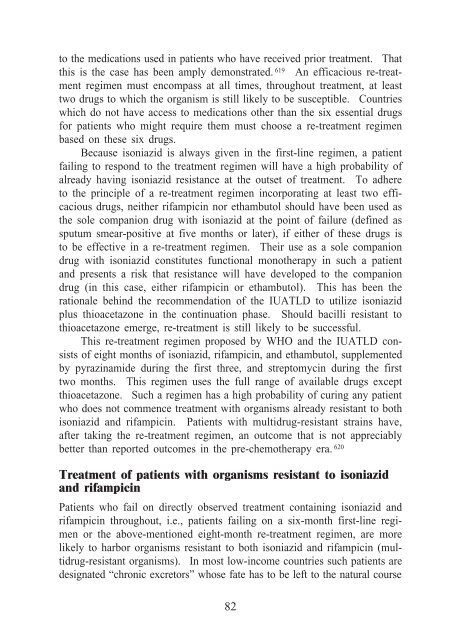Interventions for Tuberculosis Control and Elimination 2002
Interventions for Tuberculosis Control and Elimination 2002
Interventions for Tuberculosis Control and Elimination 2002
You also want an ePaper? Increase the reach of your titles
YUMPU automatically turns print PDFs into web optimized ePapers that Google loves.
to the medications used in patients who have received prior treatment. That<br />
this is the case has been amply demonstrated. 619 An efficacious re-treatment<br />
regimen must encompass at all times, throughout treatment, at least<br />
two drugs to which the organism is still likely to be susceptible. Countries<br />
which do not have access to medications other than the six essential drugs<br />
<strong>for</strong> patients who might require them must choose a re-treatment regimen<br />
based on these six drugs.<br />
Because isoniazid is always given in the first-line regimen, a patient<br />
failing to respond to the treatment regimen will have a high probability of<br />
already having isoniazid resistance at the outset of treatment. To adhere<br />
to the principle of a re-treatment regimen incorporating at least two efficacious<br />
drugs, neither rifampicin nor ethambutol should have been used as<br />
the sole companion drug with isoniazid at the point of failure (defined as<br />
sputum smear-positive at five months or later), if either of these drugs is<br />
to be effective in a re-treatment regimen. Their use as a sole companion<br />
drug with isoniazid constitutes functional monotherapy in such a patient<br />
<strong>and</strong> presents a risk that resistance will have developed to the companion<br />
drug (in this case, either rifampicin or ethambutol). This has been the<br />
rationale behind the recommendation of the IUATLD to utilize isoniazid<br />
plus thioacetazone in the continuation phase. Should bacilli resistant to<br />
thioacetazone emerge, re-treatment is still likely to be successful.<br />
This re-treatment regimen proposed by WHO <strong>and</strong> the IUATLD consists<br />
of eight months of isoniazid, rifampicin, <strong>and</strong> ethambutol, supplemented<br />
by pyrazinamide during the first three, <strong>and</strong> streptomycin during the first<br />
two months. This regimen uses the full range of available drugs except<br />
thioacetazone. Such a regimen has a high probability of curing any patient<br />
who does not commence treatment with organisms already resistant to both<br />
isoniazid <strong>and</strong> rifampicin. Patients with multidrug-resistant strains have,<br />
after taking the re-treatment regimen, an outcome that is not appreciably<br />
better than reported outcomes in the pre-chemotherapy era. 620<br />
Treatment of patients with organisms resistant to isoniazid<br />
<strong>and</strong> rifampicin<br />
Patients who fail on directly observed treatment containing isoniazid <strong>and</strong><br />
rifampicin throughout, i.e., patients failing on a six-month first-line regimen<br />
or the above-mentioned eight-month re-treatment regimen, are more<br />
likely to harbor organisms resistant to both isoniazid <strong>and</strong> rifampicin (multidrug-resistant<br />
organisms). In most low-income countries such patients are<br />
designated “chronic excretors” whose fate has to be left to the natural course<br />
82

















